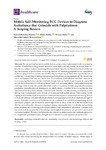Mostrar o rexistro simple do ítem
Mobile self-monitoring ECG devices to diagnose arrhythmia that coincide with palpitations: a scoping review
| dc.contributor.author | Ramsden Marston, Hannah | |
| dc.contributor.author | Hadley, Robin | |
| dc.contributor.author | Banks, Duncan | |
| dc.contributor.author | Miranda-Duro, María del Carmen | |
| dc.date.accessioned | 2020-05-22T12:37:04Z | |
| dc.date.available | 2020-05-22T12:37:04Z | |
| dc.date.issued | 2019-08-16 | |
| dc.identifier.citation | Marston HR, Hadley R, Banks D, Duro MDCM. Mobile self-monitoring ECG devices to diagnose arrhythmia that coincide with palpitations: a scoping review. Healthcare (Basel). 2019 Aug 16;7(3):96. | es_ES |
| dc.identifier.issn | 2227-9032 | |
| dc.identifier.uri | http://hdl.handle.net/2183/25618 | |
| dc.description.abstract | [Abstract] The use and deployment of mobile devices across society is phenomenal with an increasing number of individuals using mobile devices to track their everyday health. However, there is a paucity of academic material examining this recent trend. Specifically, little is known about the use and deployment of mobile heart monitoring devices for measuring palpitations and arrhythmia. In this scoping literature review, we identify the contemporary evidence that reports the use of mobile heart monitoring to assess palpitations and arrhythmia across populations. The review was conducted between February and March 2018. Five electronic databases were searched: Association for Computing Machinery (ACM), CINHAL, Google Scholar, PubMed, and Scopus. A total of 981 records were identified and, following the inclusion and exclusion criteria, nine papers formed the final stage of the review. The results identified a total of six primary themes: purpose, environment, population, wearable devices, assessment, and study design. A further 24 secondary themes were identified across the primary themes. These included detection, cost effectiveness, recruitment, type of setting, type of assessment, and commercial or purpose-built mobile device. This scoping review highlights that further work is required to understand the impact of mobile heart monitoring devices on how arrhythmias and palpitations are assessed and measured across all populations and ages of society. A positive trend revealed by this review demonstrates how mobile heart monitoring devices can support primary care providers to deliver high levels of care at a low cost to the service provider. This has several benefits: alleviation of patient anxiety, lowering the risk of morbidity and mortality, while progressively influencing national and international care pathway guidelines. Limitations of this work include the paucity of knowledge and insight from primary care providers and lack of qualitative material. We argue that future studies consider qualitative and mixed methods approaches to complement quantitative methodologies and to ensure all actors’ experiences are recorded. | es_ES |
| dc.language.iso | eng | es_ES |
| dc.publisher | MDPI AG | es_ES |
| dc.relation.uri | https://doi.org/10.3390/healthcare7030096 | es_ES |
| dc.rights | Creative Commons Attribution 4.0 International License (CC-BY 4.0) | es_ES |
| dc.rights.uri | http://creativecommons.org/licenses/by/4.0/ | |
| dc.subject | Cardiology | es_ES |
| dc.subject | Wearable devices | es_ES |
| dc.subject | Community care | es_ES |
| dc.subject | Primary care | es_ES |
| dc.subject | Technology | es_ES |
| dc.subject | Clinical care | es_ES |
| dc.subject | Scoping review | es_ES |
| dc.title | Mobile self-monitoring ECG devices to diagnose arrhythmia that coincide with palpitations: a scoping review | es_ES |
| dc.type | info:eu-repo/semantics/article | es_ES |
| dc.rights.access | info:eu-repo/semantics/openAccess | es_ES |
| UDC.journalTitle | Healthcare | es_ES |
| UDC.volume | 7 | es_ES |
| UDC.issue | 3 | es_ES |
| UDC.startPage | 96 | es_ES |






